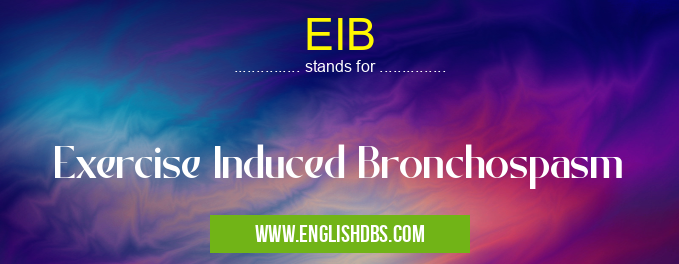What does EIB mean in PHYSIOLOGY
Exercise Induced Bronchospasm (EIB) is a condition where bronchoconstriction, or narrowing of airways, occurs after physical activity. This restricts airflow into the lungs and can cause coughing, wheezing, shortness of breath or chest tightness. The severity of symptoms can range from mild to severe depending on the individual’s medical history, age and other factors. EIB affects people of all ages, but it is most common in those who suffer from asthma or allergies. It can be managed with appropriate medications, lifestyle changes and careful planning before exercise.

EIB meaning in Physiology in Medical
EIB mostly used in an acronym Physiology in Category Medical that means Exercise Induced Bronchospasm
Shorthand: EIB,
Full Form: Exercise Induced Bronchospasm
For more information of "Exercise Induced Bronchospasm", see the section below.
» Medical » Physiology
Definition
EIB stands for Exercise Induced Bronchospasm, which refers to a tightening of the muscles in the bronchi that results in narrowed airways after physical activity such as running or playing sports. This condition can cause difficulty breathing and may result in wheezing, coughing or chest tightness due to restricted oxygen intake which can potentially lead to an asthma attack.
Causes
EIB is triggered by activities like running, jumping or other forms of aerobic exercise that increase respiratory demand and cause narrowing of airways. When individuals with respiratory sensitivities such as allergies or asthma engage in strenuous exercise their bodies overreact and produce extra mucus which causes inflammation of bronchi leading to constriction. Additionally cold air has been known to cause EIB because it exacerbates inflammation in the airways when inhaled during physical exertion.
Symptoms
The symptoms produced by EIB vary from person to person but typically include shortness of breath, chest tightness, wheezing, coughing and fatigue due to reduced oxygen intake. In more severe cases there may also be fatigue due to increased exercise related stress along with difficulty speaking normally as speaking requires some amount of breathing.
Diagnosis
Diagnosis for EIB usually involves answering questions about individual’s medical history related to allergies/asthma as well asking about any past experiences with increased respiratory demand during exercise that resulted in worsening responses compared to normal levels after restful activities such as walking around the house for example.
Treatment
Treatment for EIB depends on severity and may include inhalers like albuterol and leukotriene modifiers as well lifestyle changes like avoiding triggers such as cold air/pollution or refraining from indoor exercises if dust is an issue etc.
Essential Questions and Answers on Exercise Induced Bronchospasm in "MEDICAL»PHYSIOLOGY"
What is Exercise-Induced Bronchospasm (EIB)?
Exercise-Induced Bronchospasm (EIB) is a condition characterized by the narrowing of airways due to exercise or physical activity. This narrowing of the airways can lead to wheezing, coughing, chest tightness, and difficulty breathing.
Who can be affected by EIB?
Anyone who exercises can be affected by EIB, but it is most common in people with asthma. It can also affect those who do not have asthma but are highly sensitive to changes in temperature and humidity.
What are the signs and symptoms of EIB?
Common signs and symptoms of an EIB attack include shortness of breath, chest tightness, wheezing, coughing, difficulty catching your breath after exercise has stopped, and facial flushing.
What triggers an EIB attack?
The most common trigger of an EIB attack is cold weather combined with highly intense physical activity such as running or jogging. Other triggers include exposure to airborne irritants like smoke or pollen, and both rapid breathing and dehydration.
What should I do if I experience an EIB attack?
If you are experiencing an EIB attack you should stop your current activity immediately and take a few slow deep breaths. You may also want to try drinking some water or using a quick-relief inhaler if available.
Are there any ways to prevent an EIB attack?
While there's no surefire way to prevent an attack completely there are steps you can take such as warming up gradually before vigorous activity, avoiding outdoor activities when air pollution levels are high, covering your mouth with a scarf when exercising during cold weather, staying hydrated by drinking plenty of fluids before exercise, and using medications like anti-histamines or inhalers that help treat allergies/asthma prior to exercising.
Can medications help treat EIB?
Yes! Medications such as corticosteroids and quick-relief inhalers are often prescribed for those suffering from EIB though their effectiveness varies from person to person. It’s important that these medications are used according to instructions given by your doctor in order maximize their benefits.
Does exercise worsen my asthma?
Exercise does not worsen asthma however it is possible for exercise-induced bronchoconstriction (which includes symptoms similar to those seen in asthma attacks) to occur in individuals who record normal lung function tests under normal circumstances. It is therefore important to talk with your doctor about how best manage both conditions together if needed.
Final Words:
Exercise Induced Bronchospasm (EBI) is a condition where bronchoconstriction narrows the airways leading into the lungs resulting in difficulty breathing after engaging in strenuous activities. It is important for those who may suffer from this condition to identify their triggers so they can be avoided accordingly making sure their lifestyle includes proper medication management along with precautionary steps prior to engaging in physical activities.
